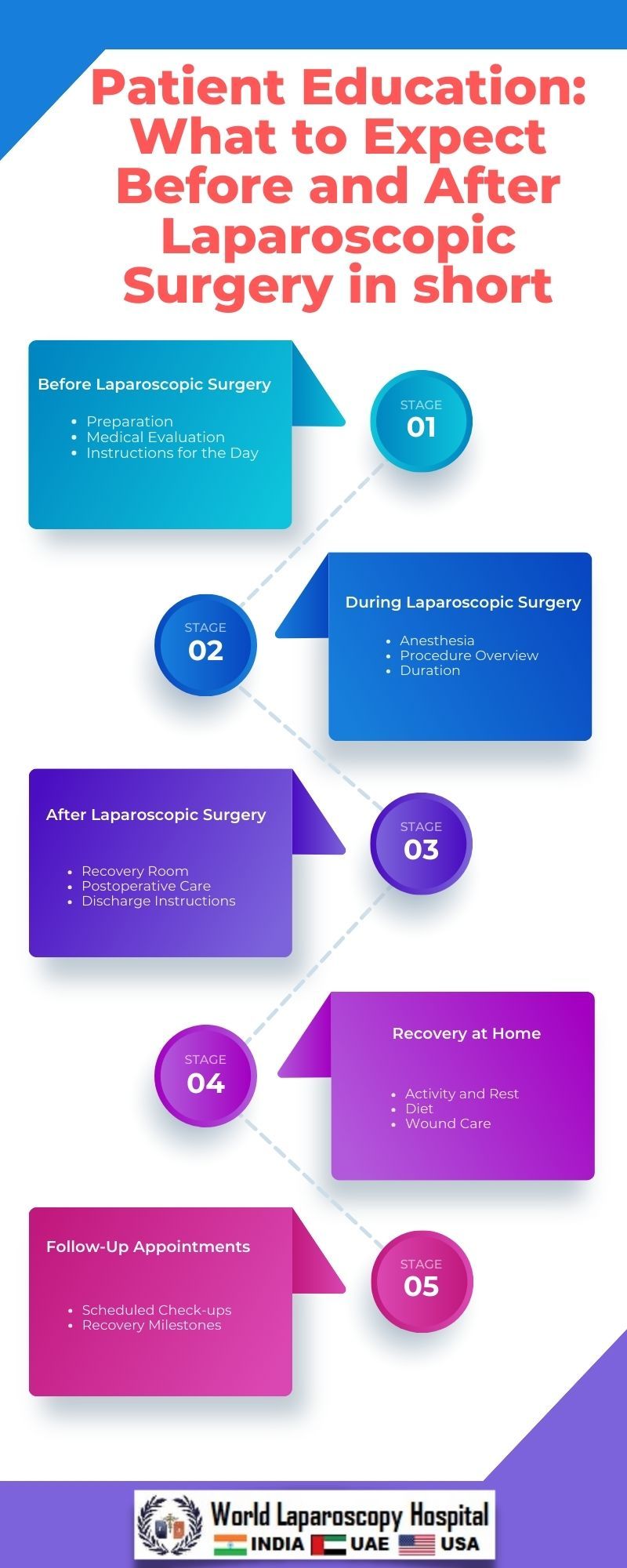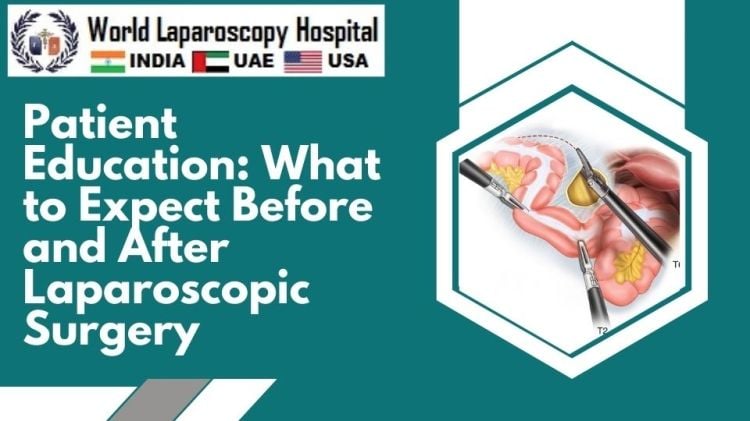Title: Patient Education: What to Expect Before and After Laparoscopic Surgery
Introduction:
Laparoscopic surgery, also known as minimally invasive surgery, has revolutionized the field of surgery, providing patients with a less invasive alternative to traditional open procedures. As you prepare for your laparoscopic surgery, understanding what to expect before and after the procedure is crucial for a smooth and successful recovery. This comprehensive guide aims to provide you with valuable insights into the various aspects of laparoscopic surgery, helping you make informed decisions and ensuring a positive patient experience.

Before Laparoscopic Surgery:
Consultation and Preoperative Assessment:
Before undergoing laparoscopic surgery, your journey begins with a consultation with your surgeon. During this meeting, your medical history will be thoroughly reviewed, and a preoperative assessment will be conducted. This evaluation helps determine your overall health, any preexisting conditions, and the suitability of laparoscopic surgery for your specific case.
Informed Consent:
Informed consent is a critical aspect of the preoperative process. Your surgeon will explain the details of the laparoscopic procedure, potential risks and benefits, and alternative treatment options. This discussion ensures that you fully understand the nature of the surgery and can make informed decisions about your healthcare.
Preoperative Instructions:
Following the consultation, you will receive specific preoperative instructions. These may include guidelines on fasting before surgery, discontinuation of certain medications, and general preparation for the day of the procedure. Adhering to these instructions is vital to ensure the safety and success of the surgery.
Psychological Preparation:
Acknowledging and addressing any anxiety or concerns you may have is essential for a positive surgical experience. Engaging in open communication with your healthcare team and seeking support from family and friends can help alleviate preoperative stress.
Physical Preparation:
Engaging in preoperative exercises and maintaining a healthy lifestyle can contribute to a smoother recovery. Your surgeon may recommend specific exercises to enhance your overall fitness, making the recovery process more manageable.
Day of Laparoscopic Surgery:
Admission and Preoperative Assessment:
On the day of the surgery, you will be admitted to the hospital or surgical center. Another preoperative assessment will be conducted to ensure that there have been no significant changes in your health since the initial consultation.
Anesthesia and Positioning:
Before the surgery, you will be administered anesthesia to ensure you are comfortable and pain-free throughout the procedure. Once asleep, your surgeon will position you on the operating table to access the targeted area with small incisions.
Trocar Placement and Carbon Dioxide Insufflation:
Laparoscopic surgery involves the use of trocars—long, thin instruments that serve as entry points for specialized surgical tools. Carbon dioxide is then introduced into the abdominal cavity to create space, allowing the surgeon a clear view and increased maneuverability.
Surgical Procedure:
The laparoscope, a thin tube with a camera and light source, is inserted through one of the trocars. Additional trocars provide access for specialized instruments used to perform the surgery. The surgeon watches a high-definition monitor to guide the instruments and complete the procedure.
Closure of Incisions:
Once the surgery is complete, the trocars are removed, and the small incisions are closed with sutures or surgical tape. The smaller incisions characteristic of laparoscopic surgery result in less scarring and a quicker recovery compared to traditional open procedures.
After Laparoscopic Surgery:
Immediate Postoperative Period: After the surgery, you will be monitored in the recovery area until you awaken from anesthesia. Pain management strategies will be implemented to ensure your comfort during the initial postoperative period.
Hospital Stay and Discharge:
Depending on the complexity of the surgery and your individual health, you may need to stay in the hospital for observation. In many cases, laparoscopic surgery allows for a shorter hospital stay compared to open surgery. Once your healthcare team determines that you are ready, you will be discharged with specific postoperative instructions.
Pain Management at Home:
Effective pain management is crucial for a comfortable recovery at home. Your surgeon may prescribe pain medication or recommend over-the-counter options. It's essential to follow the prescribed dosage and contact your healthcare team if you experience persistent or severe pain.
Activity and Mobility:
Gradual reintegration of physical activity is a key component of the postoperative period. While complete rest is necessary initially, your surgeon will provide guidelines for gradually increasing your activity level. Short walks and light exercises promote blood circulation and aid in preventing complications such as blood clots.
Diet and Nutrition:
A balanced and easily digestible diet is essential for a smooth recovery. Your surgeon will provide dietary guidelines, which may include avoiding certain foods initially and gradually reintroducing a normal diet. Adequate hydration is also crucial for the healing process.
Follow-up Appointments:
Regular follow-up appointments with your surgeon are scheduled to monitor your progress and address any concerns or complications. These appointments allow for ongoing assessment of your recovery and adjustments to your treatment plan if necessary.
Resuming Normal Activities:
As you progress in your recovery, your surgeon will provide guidance on when you can resume normal activities, including work, exercise, and other daily routines. It's crucial to follow these recommendations to prevent complications and optimize your overall well-being.
Potential Complications and Warning Signs:
Infection:
While infections are rare, it's essential to monitor for signs such as increased redness, swelling, or discharge at the incision sites. Fever and persistent pain may also indicate an infection.
Bleeding:
Excessive bleeding is uncommon but can occur. Warning signs include uncontrolled or increased bleeding from the incision sites, unusual bruising, or a drop in blood pressure.
Organ Damage:
Although rare, damage to internal organs can occur during laparoscopic surgery. Symptoms may include severe pain, difficulty breathing, or changes in urine output.
Blood Clots:
Prolonged immobility increases the risk of blood clots. Warning signs include swelling, redness, and pain in the legs. Short walks and ankle exercises can help prevent clot formation.
Allergic Reactions:
While rare, allergic reactions to anesthesia or other medications can occur. Signs include rash, itching, difficulty breathing, and swelling of the face or throat.
Conclusion:
Laparoscopic surgery offers numerous benefits, including shorter recovery times, reduced scarring, and decreased postoperative pain. Understanding what to expect before and after the procedure empowers patients to actively participate in their healthcare journey. Remember to communicate openly with your healthcare team, adhere to preoperative and postoperative instructions, and prioritize self-care for a successful recovery. By taking these steps, you can enhance the likelihood of a positive outcome and return to your daily activities with improved health and well-being.
